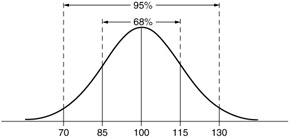Chapter 4: Working with the Normal Distribution
This chapter will explain how to use distributions of the mean to calculate confidence intervals for the population mean. It will also show how to use them to evaluate hypotheses about a population mean. The rest of the book will use ideas from this chapter to evaluate hypotheses of many kinds.
OVERVIEW
Chapter 3 mentioned that histograms show the shape of the distribution of a particular sample or population. In fact, if we draw histograms, we will notice that more often than not the shape looks like a bell. That means that most of the values are bunched in the center, and as you look farther and farther from the center, you find fewer and fewer observations.
In most applications and studies, distributions that have this bell shape turn out to be a particular type of bell-shaped distribution called the normal distribution . The normal distribution is very important in data analysis, as you will see throughout the rest of this book and in volumes 4, 5, and 6 of this series. In this chapter, you will look more closely at some characteristics of the normal distribution.
A mathematical equation defines the normal distribution exactly. For a particular mean and standard deviation, this equation determines what percentage of the observations falls where. Figure 4.1 is a picture of a normal distribution with a mean of 100 and a standard deviation of 15. As you can see, the distribution is symmetric. If you folded it in the center, the two sides would match; they are identical. The center of the distribution is at the mean. The mean of a normal distribution is also the most frequently occurring value (the mode), and it is the value that splits the distribution into two equal parts (the median). In any normal distribution, the mean, median, and mode all have the same value.

Figure 4.1: The normal distribution.
EAN: 2147483647
Pages: 252